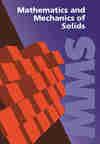Nonlinear elastic general integral equations in micromechanics of random structure composites
IF 1.7
4区 工程技术
Q3 MATERIALS SCIENCE, MULTIDISCIPLINARY
引用次数: 0
Abstract
We consider static problems for composite materials (CMs) with either locally elastic or peridynamic constitutive properties. The general integral equation (GIE) is the exact integral equationWe consider static problems for composite materials connecting the random fields at the point being considered and the surrounding points. There is a very long and colored history of the development of GIE which goes back to Lord Rayleigh. Owing to the new GIE (forming the second background of micromechanics also called the computational analytical micromechanics, CAM), one proved that local micromechanics (LM) and peridynamic micromechanics (PM) are formally similar to each other for CM of random structures. By now, the GIEs are generalized to CMs (of statistically homogeneous and inhomogeneous structures) with the phases described by local models, strongly nonlocal models (strain type and displacement type, peridynamics), and weakly nonlocal models (strain-gradient theories, stress-gradient theories, and higher-order models). However, a fundamental restriction of all mentioned GIEs is their linearity with respect to a primary unknown variable. The goal of this study is obtaining nonlinear GIEs for PM, and, in a particular case, for LM. For the presentation of PM as a unified theory, we describe PM as the formalized schemes of blocked (or modular) structures so that the experts developing one block need not be experts in the underlying another block (this is a good background for effective collaborations of different teams in so many multidisciplinary areas as PM). The opportunity for the creation of this blocked structure of the PM is supported by a critical generalization of CAM which is extremely flexible, robust, and general.随机结构复合材料微观力学中的非线性弹性一般积分方程
我们考虑的是具有局部弹性或周动构成特性的复合材料(CMs)的静态问题。一般积分方程(GIE)是精确的积分方程。我们考虑的是复合材料的静态问题,它连接了被考虑点和周围点的随机场。GIE 的发展历史可以追溯到 Lord Rayleigh。由于新的 GIE(构成微观力学的第二个背景,也称为计算分析微观力学,CAM),人们证明了对于随机结构的 CM,局部微观力学(LM)和周动微观力学(PM)在形式上彼此相似。到目前为止,GIEs 已被推广到由局部模型、强非局部模型(应变类型和位移类型、周动态)和弱非局部模型(应变梯度理论、应力梯度理论和高阶模型)描述相位的(统计均质和非均质结构的)CM。然而,所有上述 GIE 的一个基本限制是它们与主要未知变量的线性关系。本研究的目标是获得 PM 的非线性 GIE,以及在特定情况下 LM 的非线性 GIE。为了将 PM 表述为一种统一理论,我们将 PM 描述为分块(或模块)结构的正规化方案,这样,开发一个分块的专家就不必是另一个分块底层的专家(这是不同团队在 PM 等多学科领域进行有效合作的良好背景)。创建这种项目管理分块结构的机会得到了 CAM 的关键性概括的支持,CAM 非常灵活、强大和通用。
本文章由计算机程序翻译,如有差异,请以英文原文为准。
求助全文
约1分钟内获得全文
求助全文
来源期刊

Mathematics and Mechanics of Solids
工程技术-材料科学:综合
CiteScore
4.80
自引率
19.20%
发文量
159
审稿时长
1 months
期刊介绍:
Mathematics and Mechanics of Solids is an international peer-reviewed journal that publishes the highest quality original innovative research in solid mechanics and materials science.
The central aim of MMS is to publish original, well-written and self-contained research that elucidates the mechanical behaviour of solids with particular emphasis on mathematical principles. This journal is a member of the Committee on Publication Ethics (COPE).
 求助内容:
求助内容: 应助结果提醒方式:
应助结果提醒方式:


